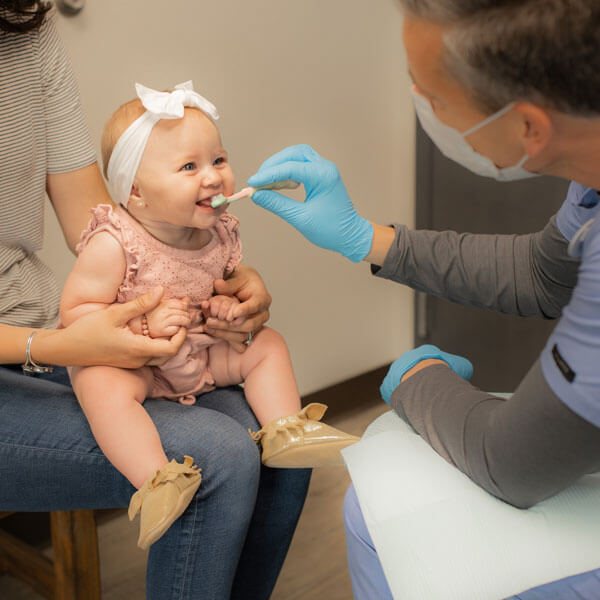Fluoride

What is fluoride?
Reduce your Little Surfer's risk for cavities!
Fluoride is a natural mineral that can help protect teeth from decay. It hardens your child’s teeth and helps to reduce their risk for cavities. It can also reverse early signs of tooth decay!
Similar to brushing, flossing, and visiting your pediatric dentist, fluoride is an essential part of your little surfer’s oral health care.
How does fluoride work?
As your child eats or drinks, the bacteria in their mouth feeds on the sugars in their diet. This produces an acid attack on their teeth, stripping away calcium and phosphate and leaving them more vulnerable to decay.
Saliva plays a key role in defending their teeth from these acid attacks, but often it’s not enough. That’s where fluoride comes in!
Fluoride works to strengthen and remineralize the enamel layer of teeth. It repairs weakened teeth and protects them against cavities.
Different Sources of Fluoride
There are many ways that your little surfer can get this health benefit. Here are the most popular ways!
Water
Water fluoridation is the process of adjusting the level of fluoride in a public water system to fight cavities. In 2016, 72.8% of the US population had access to fluoridated water. However, some water sources, like well water, do not have the recommended level for maximum protection against cavities. This will be discussed during your child’s dental visit.
Diet
Fluoride is found in many foods and drinks. The more processed the food is, the higher the likelihood that it has fluoride. However, ingesting high levels of fluoride isn’t necessarily a good thing (scroll to our FAQ to read why). Having your child eat a balanced diet will help them receive a healthy and sufficient amount.
Toothpaste
Brushing teeth with fluoride toothpaste is highly effective as it allows the enamel to absorb it directly. The American Academy of Pediatric Dentists recommends that children use fluoridated toothpaste (see our FAQ below for the recommended amounts). Your child can also obtain fluoride with fluoridated mouthwash.
Treatment
Our pediatric dentists in Richland offer a topical fluoride treatment, which is more concentrated than other sources and is very effective in fighting decay. For children under 16, we recommend this treatment at least twice a year. If your child already shows signs of decay, we may recommend silver diamine fluoride.
So, you might be wondering – what’s the best source? At Smile Surfers Kids Dentistry, we recommend a healthy combination of all four!
What To Know About Sweets
FAQs About Fluoride
Check out the answers below!
What is silver diamine fluoride?
Silver diamine fluoride is a clear blue liquid that contains both silver and fluoride. The silver helps penetrate into the surface of the enamel and kill cavity-causing bacteria, while the fluoride helps remineralize and strengthen the tooth. When used together in silver diamine fluoride, they can slow down or stop dental decay.
If your child shows signs of decay but is too young or unable to receive restorative treatment at the moment, we may recommend silver diamine fluoride. This fluoride treatment can stop decay from worsening and buy us time until your child can receive proper treatment.
Is fluoride safe for children?
Yes, it is safe when consumed or applied in small doses.
Fluoride dental products like toothpaste and mouthwash are safe as long as they are not swallowed. Consuming too much can cause dental fluorosis, which affects teeth still forming under the gums and results in white spots on the surface of teeth.
At Smile Surfers Kids Dentistry, our topical fluoride treatment and silver diamine fluoride are both safe and highly effective.
How much fluoride toothpaste should my child use?
How much does this treatment cost? Does insurance cover it?
Fluoride is typically covered by dental insurance.
In some cases, your insurance policy may only cover this treatment once per year. In that case, we will work with you to find a solution so that your child can receive the ADA and AAPD recommendation of twice per year.
If you would like a cost estimate or want to verify your insurance coverage, please contact our friendly team!
What is a caries risk assessment?
A Caries Risk Assessment is a preventative test to determine your little surfer’s risk of getting cavities. With this knowledge, our pediatric dentists can tailor their at-home advice and treatment recommendations to keep your child from developing dental problems.
Fluoride plays a role in the Caries Risk Test, which is why we will want to know your child’s:
- Water consumption
- Quality of water
- Diet
- Toothpaste
- Mouthwash
- Dental hygiene routine